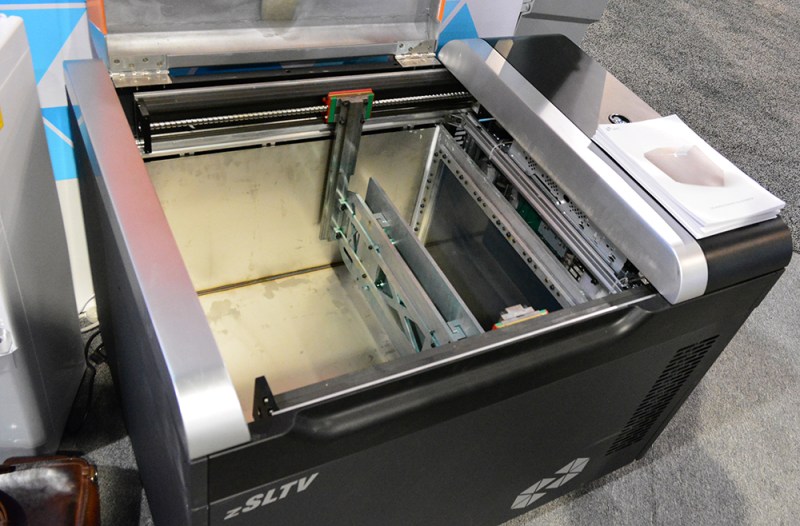Last year at CES, UniZ introduced the Slash, a desktop resin printer. It’s fast, it’s capable, and it’s shipping now, but there was something else in the UniZ booth that had a much bigger wow factor.
The UniZ zSLTV is a gigantic box, a little more than one meter wide, and a little less than one meter tall and deep. Open the lid, and you see a gigantic resin printer turned on its side. The idea here is to fill a gigantic tank with resin, (the build volume is 521 x 293 x 600 mm) and use it as a fairly standard UV LED / LCD resin printer. The only real difference between this machine and any other resin printer is that the part is always submerged in resin.
It’s something we’ve never seen before, and it will be available ‘soon’. The price for this huge machine is in the ballpark of $10,000.



















That means if you want to change resins, you need to drain all that resin back into old container, wash the bin and have big batch of other resin at hand. You need a part that is bug but mostly hollow? Nope, 100g of resin won’t be enough for a 20g part.
Print speed?
1 slice 2 sec.
Assuming 0,1mm Layer height that would be 20sec per mm or 3,3h for the full volume..
Wow that’s pretty fast!
Where are you getting these numbers from? Their website has almost no information on it.
Can it print the full build volume per slice? 100 microns is decent but not amazing resolution. 10 microns would be pretty fine resolution but would take 33 hours assuming it scales linearly and can actually achieve that resolution to begin with.
Also, what does this resin cost? I have sourced resins before as raw materials and they in bulk still cost several dollars per pound (or more). This thing can hold a little over 25 gallons? That’s in the ballpark of 225 pounds of resin! So looking at around $4000 to $8000 per resin bath at raw cost, not even retail pricing? Would also need a means of easily swapping and storing resins, unless you dedicate the entire machine to this.
This is a pretty neat concept if the resolution and speed is there.
Ahh, the video reports those numbers but it doesn’t specify the build height. As you scale things up, you tend to lose resolution. What kind of XYZ resolution can this machine produce? If the speed is quick but the resolution is terrible, that’s probably not a good trade-off.
I may be ignorant, but what is the benefit of the part being fully submerged?
Top down machines do this too.
Are they trying to do a superspeed print this way?
reducing adhesion problems sourced by gravity (he said in the video)
Didn’t have time to watch the videos.
That seems odd to me, most adhesion problems are the build sticking to the base (side in this case) stronger than the build plate. I don’t see how sideways gravity would fix that.
Sideways mounting in the same density fluid as the cured model material means that everything is, in theory, supported and not being dangled from above. Unclear how much of an advantage this actually brings to things but it could be an improvement to traditional “top down” machines. This would all be, to a degree, geometry dependent.
@Brian You should check out the 3D Printer that prints metal. MarkForged over in the Sands Hall. $98K is still pricey, but it seeps to be getting closer to the hobby market.
“303 stainless steel is great for post processing in CNC milling and turning operations. It maintains corrosion resistance up to 800C. We use it in the drive roller for our fiber system on the Mark X. 17-4 stainless steel combines high strength, corrosion resistance, and hardness, making it widely used in aerospace, medical and petroleum industries. We use it for assembly fixtures and tooling on the Mark X.”
They use 303 stainless in the drive roller and 17-4 in the assembly fixtures and tooling as a raw material that is processed elsewhere using traditional fabrication methods or they use it directly off the machine in other machines, using their machine to build other machines? That part seems very unclear.
Is their software cloud based? If so that’s an instant deal breaker.
Also, how do you dissolve the plastic completely and not have issues with porosity or density or warpage or strength problems?
Nice threadjack. You could have just sent Brian a note as a PM.